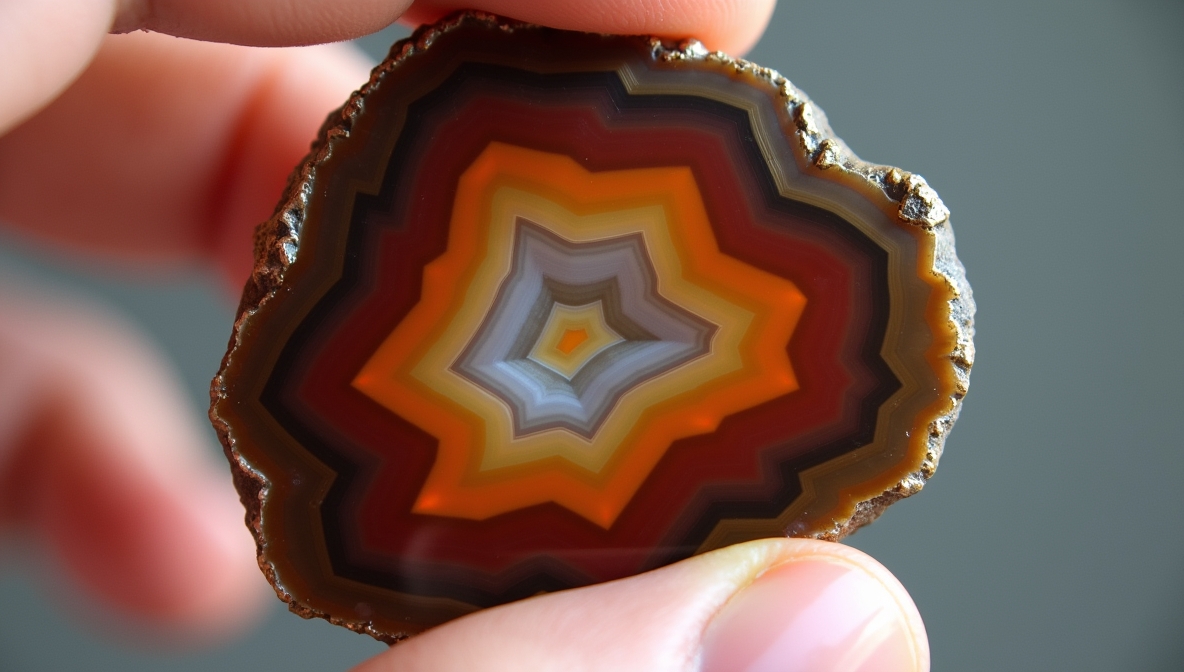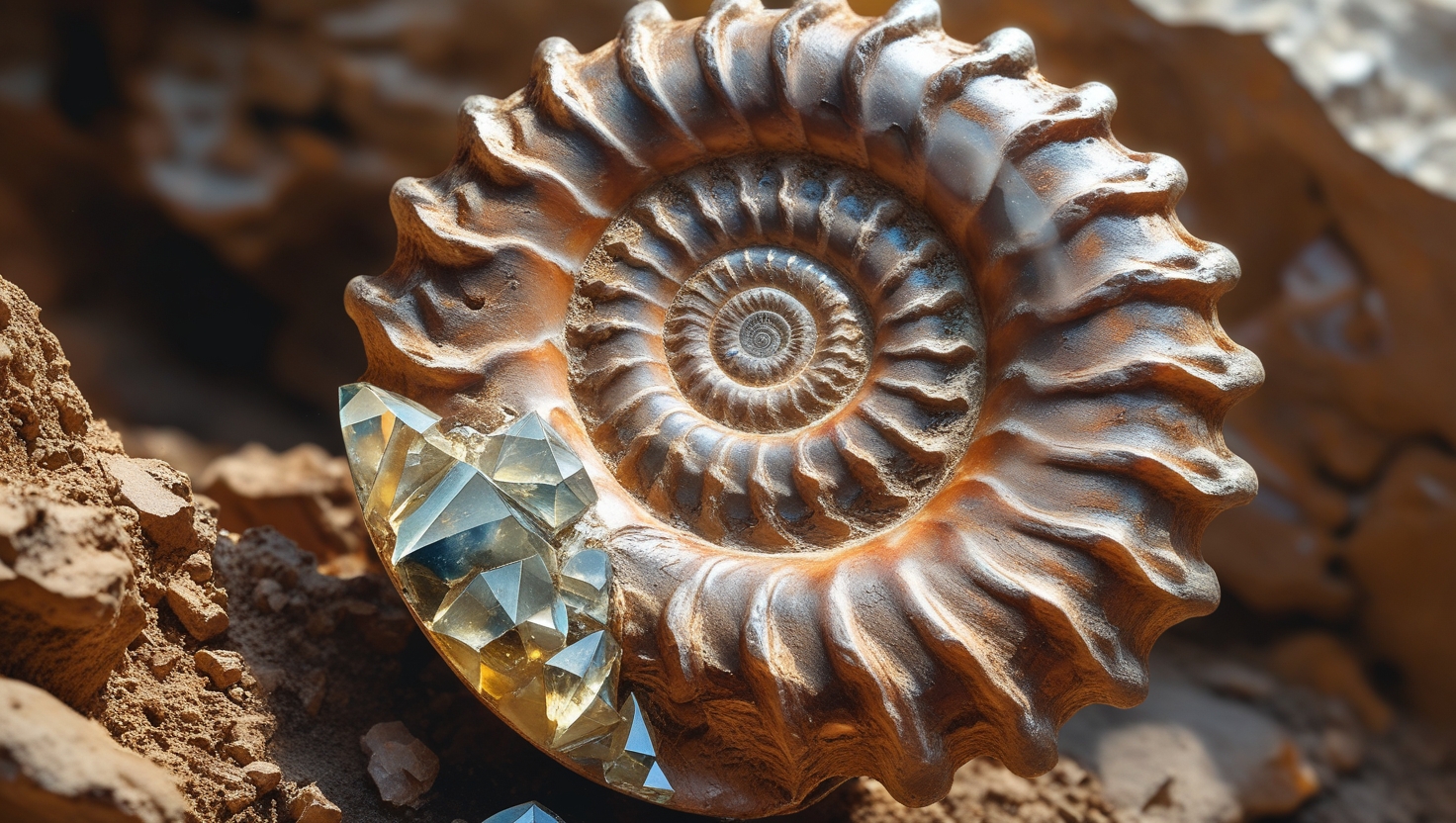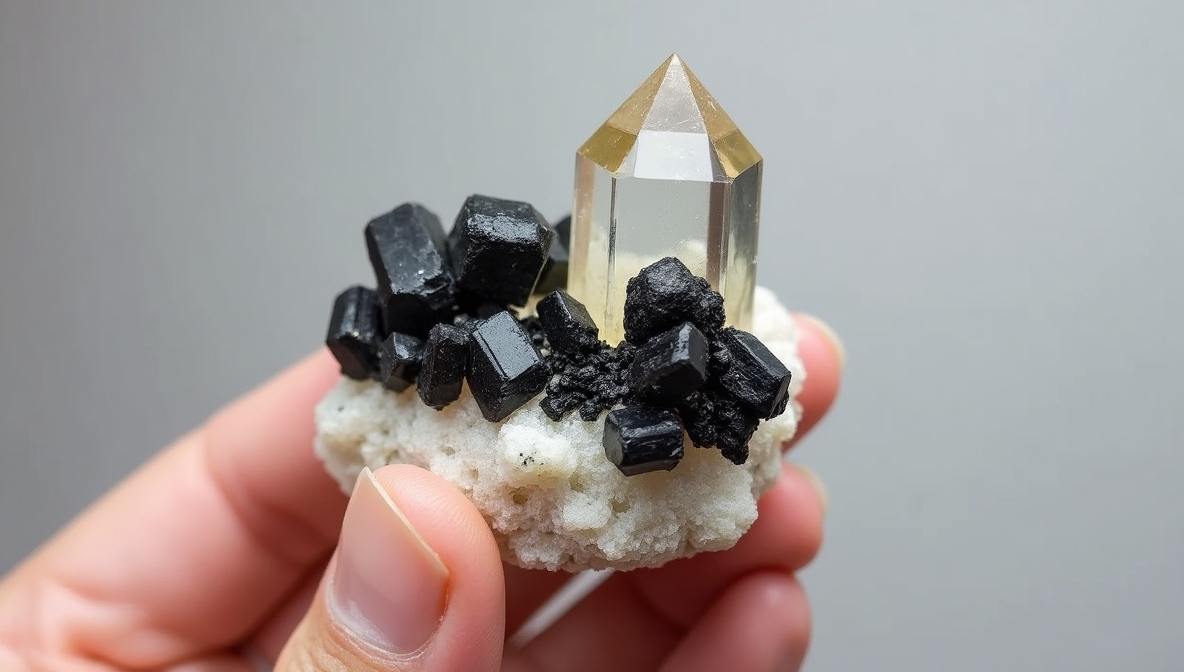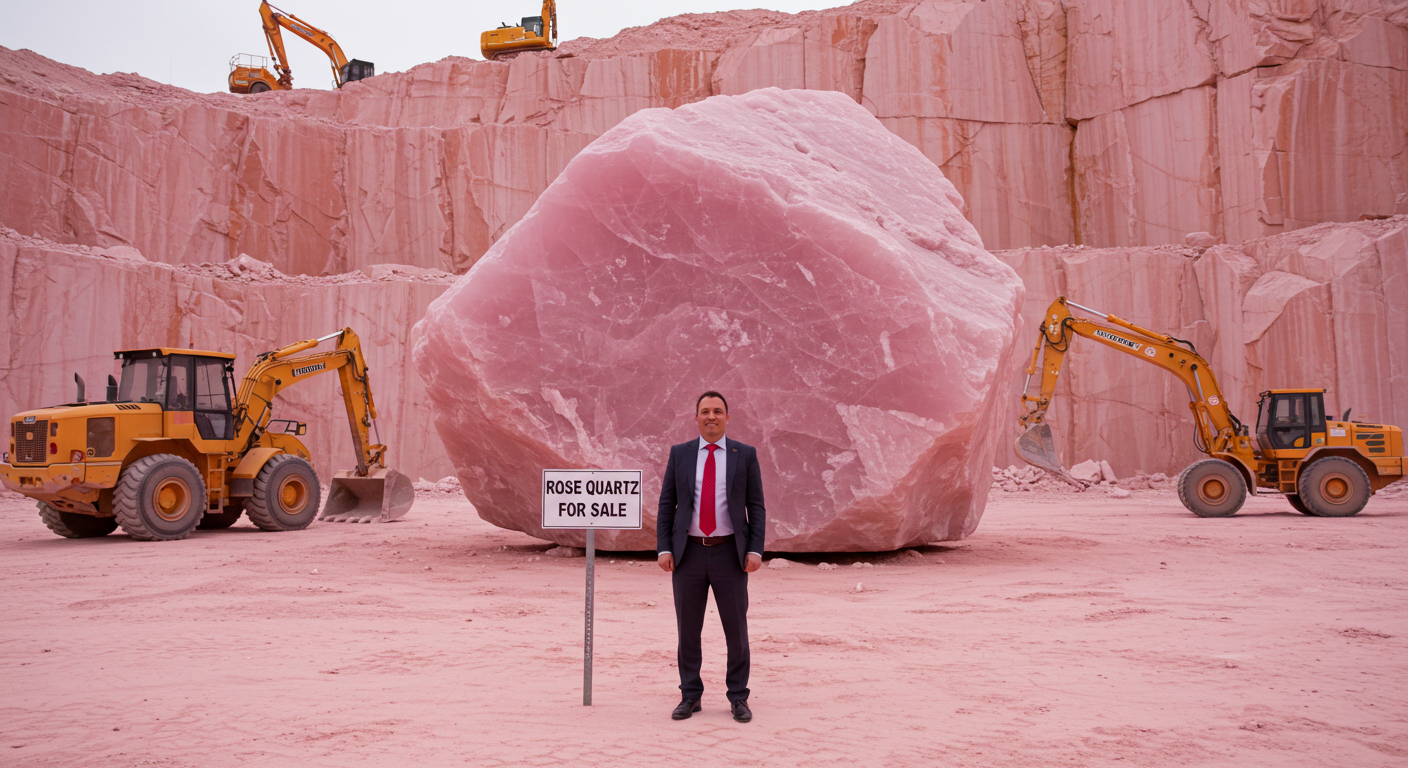See this incredible Clear Quartz, Black Tourmaline, and the Human Connection. Explore its intricate patterns and natural beauty.
Observe the image before you: a close-up view, intimate and revealing. In a gently cupped hand, resting against a plain light grey background illuminated by soft natural light, lies a mineral specimen of extraordinary visual and geological interest. A prominent clear quartz crystal point stands as the focal point, its precise geometry softened by the way it is held, yet its clarity stark. But what truly captivates is the dramatic juxtaposition: dark, opaque black tourmaline crystals pierce through, intertwine with, and accompany the translucent quartz. It is a dance of light and shadow, transparency and opacity, form and counter-form – a striking contrast captured in stone and presented by a human touch.
This isn’t just a collection of crystals; it’s a story written in mineral form, a snapshot of dynamic processes deep within the Earth, and a powerful reminder of the raw, abstract beauty that nature is capable of creating. The deliberate presentation – held in a hand, under natural light, in sharp focus – invites us to lean in, observe the details, and appreciate the intricate relationship between these geological characters.
Let us explore the layers of meaning and wonder held within this compelling specimen.
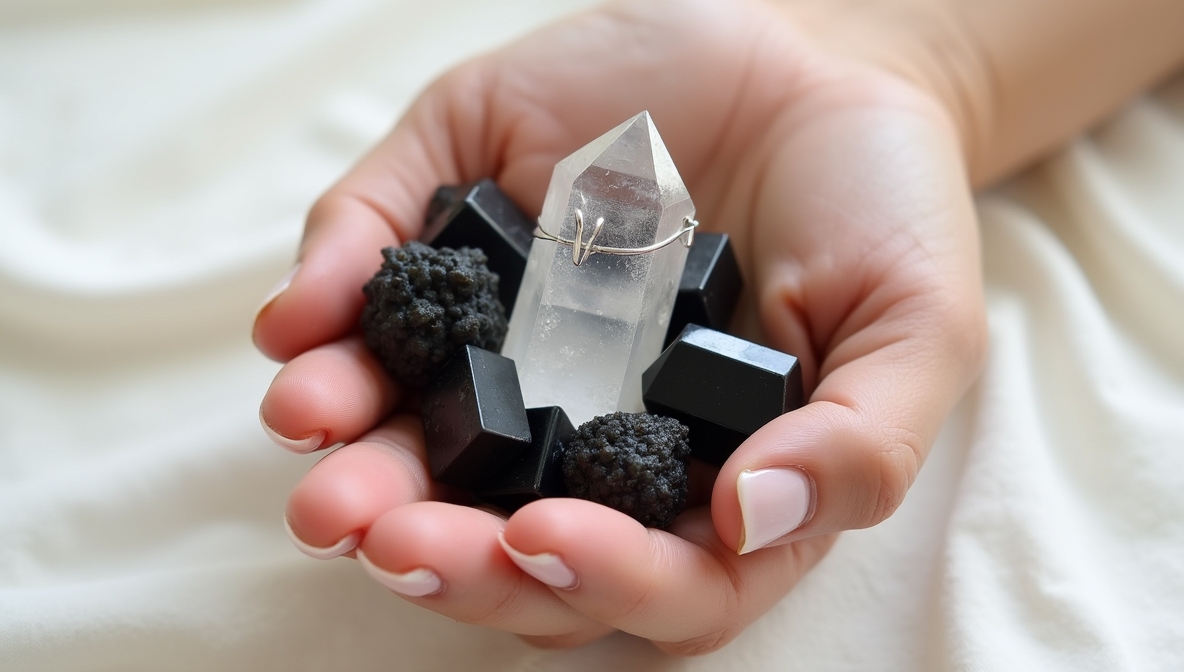
The Characters: Quartz and Tourmaline
To understand the narrative, we must first meet the protagonists:
- The Clear Quartz Point: Quartz (SiO₂) is one of the most ubiquitous minerals on Earth, the foundation of much of its crust. Yet, a well-formed, clear crystal point is anything but common in its perfection. The “point” signifies a terminated crystal, meaning it grew unimpeded in at least one direction, forming the characteristic pyramidal tip that defines a quartz crystal’s growth habit. The “clear” aspect is crucial; it means the silica lattice is pure and free of significant impurities or structural defects that would scatter light. Clear quartz embodies qualities of clarity, light transmission, and a fundamental, ordered structure. Its faces are typically smooth planes, reflecting and refracting light with a glassy (vitreous) luster. In this specimen, the large, terminated point gives it prominence and elegance, standing tall and translucent.
- The Dark Black Tourmaline Crystals (Schorl): Black tourmaline, primarily the iron-rich variety known as Schorl, stands in stark opposition to the quartz. Chemically complex (a boron silicate mineral with a variable composition), its form is typically prismatic, often with noticeable vertical striations running along the length of the crystal faces. These crystals usually terminate in complex, often three-sided forms. The key characteristic here is its color – intensely dark, opaque black. This is due to the presence of iron within its chemical structure. Black tourmaline absorbs light, offering a visual weight and grounded presence that contrasts sharply with the light-handling nature of clear quartz. It is solid, rooted, absorbing the light that the quartz transmits.
The Interaction: Piercing and Accompanying
The real magic of this specimen lies in the interaction between these two minerals. It’s not just quartz and tourmaline; it’s quartz with tourmaline, specifically in a way that highlights their simultaneous growth:
- Piercing: This is the most dramatic element. It means tourmaline crystals grew through the growing quartz crystal. This isn’t the tourmaline forming first and the quartz growing around it (though that happens too, resulting in simple inclusions). “Piercing” suggests a competitive or co-equal growth environment where both crystals were expanding into the same space at roughly the same time. Imagine two different plant species growing their stems and roots into the same volume of soil, their structures intertwining and pushing past each other as they simultaneously grow. The clear nature of the quartz is essential here, as it allows us to visually trace the path of the black tourmaline crystals as they penetrate its interior, creating natural, linear patterns suspended within the transparent host. These black lines, seemingly defying the purity of the quartz, tell a powerful story of simultaneous, sometimes intrusive, growth.
- Accompanying: This refers to tourmaline crystals growing alongside the quartz, attached to its external surfaces, or perhaps originating from the same base matrix. They are partners in crystallization, sharing the same geological neighborhood. Some tourmaline crystals might be fully formed prisms resting against the quartz face, others might originate from the base and run up the side of the quartz point. These accompanying crystals reinforce the visual dialogue – the presence of the dark form alongside the light, the opaque next to the transparent.
This intergrowth and mutual intrusion tell a precise geological story. It indicates that the conditions in the mineralizing fluid (rich in silica, boron, iron, etc.) were suitable for both quartz and tourmaline to crystallize simultaneously. They grew side-by-side, vying for space, sometimes with one crystal structure enveloping or being penetrated by the other. The resulting specimen is a snapshot of that dynamic growth process, captured in solid form.
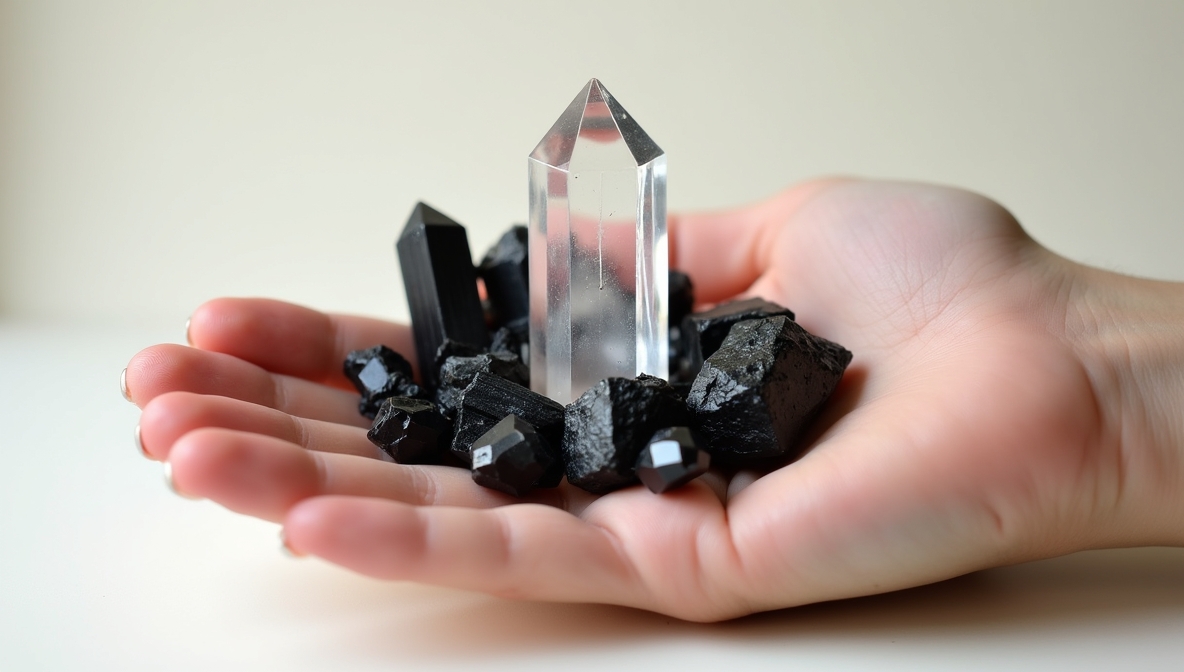
The Foundation: The White Druzy Albite Matrix
Beneath this dramatic intergrowth lies the matrix – the base rock or mineral on which the crystals grew. In this specimen, it’s described as “white druzy Albite.”
- Albite: A member of the plagioclase feldspar group, albite (NaAlSi₃O₈) is a very common mineral, often found in granite pegmatites and hydrothermal veins – precisely the environments where large quartz and tourmaline crystals form.
- White: Its color provides a clean, neutral base that makes the black tourmaline and clear quartz stand out vividly, amplifying their contrast. It’s the canvas upon which the main characters perform.
- Druzy: This term refers to a surface covered in a myriad of small, microcrystalline crystals. In this case, the Albite on the surface didn’t form large, blocky crystals, but rather a sparkling layer of tiny, interlocking crystals that reflect light. This druzy texture provides a third textural element in the specimen – the smooth facets of the large quartz, the often striated faces of the tourmaline, and the fine sparkle of the albite base. It signifies a later stage of slower crystallization, perhaps lining the remaining cavity space after the main quartz and tourmaline growth.
The white druzy albite matrix is the bedrock, the stage upon which the dramatic growth of the quartz and tourmaline played out. It anchors the composition, provides essential context about the geological environment from which these crystals emerged, and adds a subtle layer of visual interest with its delicate sparkle and uniform lightness.
The Striking Contrast: A Visual and Existential Dialogue
The prompt highlights “striking contrast.” Let’s fully appreciate this central theme, as it’s the heart of the specimen’s aesthetic power:
- Color Contrast: The most immediate and impactful contrast is color. The stark, deep black of the tourmaline against the colorless clarity of the quartz and the pure white of the albite matrix is visually arresting. Black and white are the ultimate opposites on the value scale, and the transparent intermediary (clear quartz) adds complexity to this binary.
- Transparency Contrast: The clear quartz is transparent, allowing light to pass through and revealing its internal structure (and the tourmaline within!). The black tourmaline is opaque, absorbing light. This creates a dynamic interplay of light and shadow within the specimen itself. You look through the quartz, but your gaze stops at the surface of the tourmaline.
- Form Contrast: While both are crystalline, their forms differ. The quartz is typically hexagonal with sharp terminations; the tourmaline is prismatic, often with rounded triangular cross-sections and vertical striations. The perfect, smooth faces of the quartz contrast with the often rougher or striated surfaces of the tourmaline and the micro-crystalline texture of the druzy albite.
- Energy/Symbolic Contrast: In metaphysical or symbolic terms, clear quartz is often associated with light, clarity, amplification, and spiritual energy. Black tourmaline is associated with grounding, protection, absorbing negativity, and connection to the Earth. Their presence together in a single specimen can be seen as a powerful symbol of balance – bringing light into grounded energy, or grounding expansive clarity. Even purely visually, the light-transmitting quartz feels airy and expansive, while the light-absorbing tourmaline feels solid and rooted.
This specimen is a natural masterpiece of contrast, demonstrating how opposing elements can coexist and even enhance each other’s beauty when brought together through natural processes.

The Human Connection: Held in the Hand
The presence of the human hand is far from incidental; it’s a crucial element of the photograph’s narrative and impact.
- Scale and Tangibility: The hand instantly provides scale. We understand the size and weight of the specimen in a way a ruler or scale bar cannot convey. It makes the specimen feel real, something that can be held, examined, and appreciated directly. We can imagine the coolness of the stone, the different textures under our fingertips.
- Relationship and Care: The gentle way the hand cups the specimen suggests care, appreciation, and a connection between the human and the mineral. It’s not just an object on display; it’s being presented, shared, and protected. It implies a sense of wonder and respect for the natural object.
- Bridging Time: The warm, soft, temporary flesh of the hand cradling the cold, hard, ancient stone creates a powerful juxtaposition. It highlights the immense difference in timescale – the fleeting moment of a human life connected to a mineral that took millennia to form and has existed for millions of years. It’s a physical link across deep time, a hand reaching back through geological epochs.
- Aesthetic Harmony: As with the mineral components, the organic curves, texture, and skin tone of the hand provide a soft, natural contrast and frame for the hard, geometric forms and stark colors of the mineral. It adds warmth and life to the composition, making it more relatable and visually appealing.
The hand transforms the photo from a scientific documentation into a story about discovery, appreciation, stewardship, and the enduring human desire to connect with the natural wonders of our planet. It makes the specimen accessible on a personal level.
The Art of Revelation: Photography Choices
The photographic details specified – close-up, sharp focus, plain light grey background, natural lighting – are not arbitrary. They are deliberate choices that enhance the viewing experience and highlight the specimen’s qualities.
- Close-up: This perspective allows the viewer to get intimate with the specimen, focusing on the precise details of the intergrowth, the surface textures, and the clarity (or opacity) of the crystals. It reveals the miniature landscapes and intricate structures that would be lost in a wider shot, emphasizing the ‘piercing’ action.
- Sharp Focus: Essential for clarity and detail. Every facet edge on the quartz, every striation on the tourmaline, the texture of the druzy albite, and the intricate points of contact between the minerals are rendered with precision. Sharp focus allows the viewer to visually explore the specimen’s textures and forms as if examining it up close.
- Plain Light Grey Background: A neutral backdrop is critical for specimen photography, especially when showcasing contrast. Light grey is soft, non-distracting, and doesn’t introduce competing colors or harsh shadows. It allows the true colors and textures of the minerals (the clear quartz, black tourmaline, white albite) to stand out vividly without distortion or color cast, emphasizing the specimen as the sole subject.
- Natural Lighting: This is a powerful choice. Natural light (like diffused daylight) tends to be softer and more even than artificial light, especially direct flash.
- Softness: Minimizes harsh shadows that could obscure details or create unnatural contrasts, allowing the forms to be clearly seen.
- Evenness: Illuminates all parts of the specimen relatively equally, preventing some areas from being blown out (too bright) or lost in shadow, which is crucial for seeing both the clear and opaque parts effectively.
- Authenticity: Natural light reveals the true color, clarity, and luster of the minerals as they would appear in natural conditions.
- Transparency/Clarity: For the clear quartz, natural light penetrates beautifully, illuminating the internal structure and highlighting the black tourmaline inclusions without causing excessive, distracting internal reflections that can happen with point sources.
The combination of these photographic techniques creates an image that is both highly detailed and aesthetically compelling, serving as an ideal, honest representation of the specimen’s natural beauty, geological narrative, and visual drama.
The Deep History: A Moment in a Pegmatite or Hydrothermal Vein
This specific mineral association – clear quartz, black tourmaline (Schorl), and albite feldspar – is a classic assemblage found in granite pegmatites or certain types of hydrothermal veins. These environments form from hot, mineral-rich fluids circulating deep within the Earth’s crust.
In these fluid-rich conditions, crystals can grow rapidly and to significant size. The presence of all three minerals suggests a fluid composition rich in silicon, oxygen, aluminum, sodium, boron, and iron. The “piercing” and “intergrown” nature tells us that the conditions were favorable for both quartz and tourmaline to crystallize simultaneously, competing for space in the same cavity over geological timescales. The albite likely formed earlier, providing the surface for the main event.
This specimen is a direct, frozen record of that dynamic crystallization process – a moment captured in stone from the fiery, fluid depths of the Earth.
Beyond the Image: Significance and Appreciation
Why does an image like this, and the specimen it depicts, resonate so deeply?
- Natural Artistry: It is a stunning example of nature’s ability to create objects of incredible beauty, form, and complexity through purely natural processes. The visual ‘story’ of the intergrowth is captivating.
- Geological Storytelling: It’s a tangible piece of Earth’s history, telling a specific story about mineral formation, environmental conditions, and the passage of geological time.
- Scientific Insight: Such specimens are invaluable for mineralogists and geologists studying crystal growth mechanisms, mineral associations, and the environments in which they form.
- Symbolism: The stark contrast and interaction can evoke powerful ideas of balance, integration of opposites, light within darkness, or strength in union.
- Rarity and Value: While the individual minerals are common, specimens with this level of clarity, form, dramatic intergrowth, and aesthetic presentation on a clean matrix are rare and highly sought after by collectors and museums.
The close-up photo, held gently in a human hand under natural light, maximizes our ability to appreciate all these facets – the scientific, the aesthetic, and the deeply human connection to the natural world.
Conclusion: A Glimpse into Earth’s Dynamic Artistry
The image of a hand holding a clear quartz point pierced and accompanied by dark black tourmaline crystals on a white druzy albite matrix is far more than a simple photograph of minerals. It is a carefully composed visual narrative showcasing a moment of geological drama and stunning natural beauty.
It captures the striking contrast between the light-filled clarity of quartz and the grounded opacity of black tourmaline, illustrating their dynamic intergrowth as they grew together deep within the Earth. The white druzy albite provides the perfect stage, and the human hand adds scale, warmth, and a profound sense of connection across immense stretches of time.
Illuminated by natural light and rendered in sharp focus, every detail of this natural sculpture is revealed, inviting the viewer to marvel at the complexity and artistry inherent in the mineral kingdom. This specimen, held gently in a hand, serves as a powerful reminder that even within the seemingly inanimate world of rocks and crystals, there are stories of dynamic growth, striking relationships, and a deep, enduring beauty waiting to be discovered and appreciated. It is a piece of the planet, presented for us to admire, study, and connect with, revealing the hidden complexity and stunning artistry of the geological world.

